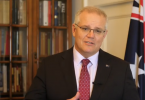How does a person come to believe that JFK Junior, who died in a plane crash in 1999, is coming back from the dead at the exact time of day and location that his father was assassinated? How does that same person come to believe, when 12.29pm passes without a resurrected JFK Jr returning and declaring himself Donald Trump’s 2024 running mate, that he will show up at the Rolling Stones concert at Dallas later that evening? How does that same person come to believe, that when JFK Jr doesn’t show up at the Rolling Stones concert, that he was there the entire time, because JFK Jr is actually Keith Richards in disguise? How is that same person not alone in believing these things, but rather is one of hundreds who lined the streets of Dealey Plaza, Dallas for hours sharing the same beliefs?
When Kellyanne Conway, counsellor to former President Donald Trump, said in a January 2017 interview that there were “alternative facts”, she was knowingly or unknowingly fertilising the ground in which misinformation and disinformation grows. In the world of misinformation and disinformation, there are no shared facts, rather any statement of fact is countered with an alternative fact. In such environments, the return of JFK Jr as Donald Trump’s 2024 running mate becomes plausible.
In order to communicate, words must have a shared meaning. When I use a word, I understand that you share the same or similar meaning of that word. This shared meaning allows us to have a conversation. It allows journalists to communicate news, facts and stories to the public. However, when words no longer have shared meanings, they become entirely subjective. And at that moment societies lose the ability to communicate.
In Lewis Carroll’s Alice in Wonderland, the character Humpty Dumpty says, “When I use a word it means just what I choose it to mean — neither more nor less.” The articulation of “alternative facts” by Kellyanne Conway is a reformulation of the Humpty Dumpty assertion. By substituting facts for words, Conway’s “alternative facts” translate into: facts mean what I want them to mean — neither more, nor less.
It is in this world of subjective words and subjective facts that disinformation is weaponised. The fourth estate, ill-equipped to challenge the subjectification of word and facts, became part of a feedback loop of misinformation and disinformation. Consequently, deep social divides, rather than rational arguments, were the feature of the Brexit debate. Allegiance to personalities rather than facts allowed Donald Trump’s “big lie” of election fraud to gain credence. Most recently, such disinformation is apparent in the claims of Russian President Vladimir Putin that his invasion of Ukraine is for the purpose of “denazifying” Ukraine. When words and facts mean what you want them to mean, it is unnecessary to provide evidence of Nazis occupying Ukraine – all that is necessary is to say it is so.
The extraordinary power of disinformation is on full display in the reporting coming out of Ukraine — not about the war, but about civilians attempting to communicate to their Russian relatives the reality of the war. Ukrainian civilians are calling their relatives in Russia — in some instances it is a child calling their parent — and telling them that Ukraine is under Russian invasion, that Kyiv is being bombarded and that civilians are being killed. Often their Russian relatives do not believe them.
This is the extraordinary power of the disinformation ecosystem. Those constantly exposed to the “alternative facts” on Russian state TV — that there is no invasion, that any such invasion is justified, that the Russian troops are liberators — have no reason to question, let alone seek to verify, the “alternative facts”. Even when disconfirming evidence comes from close relatives. Putin has, with devastating power, weaponised the Humpty Dumpty model. Words like “war” and “special operation” and “denazify” mean what he means them to mean —neither more, nor less.
This Humpty Dumpty model of morphing the meaning of words into having purely subjective meaning, is the foundation for the creation of subjective facts. It makes the unthinkable plausible, the impossible possible and transforms many people with access to large audiences unaccountable.
A society that cannot share the meaning of words, that cannot share facts, will fill the void with whatever purported facts suit the agenda of those with access to large audiences. In such a society disinformation prevails. In such an environment, it is incumbent on the Fourth Estate to seek facts and challenge “alternative facts” and to restore the shared meaning of words – neither more nor less.
Featured image: QAnon conspiracy theorists attend the ‘Million MAGA March’ at Washington D.C on November 14, 2020. The protest was attended by thousands of protesters, including QAnon conspiracy theorists, claiming that the 2020 U.S election had been stolen because of voter fraud. Photo: Geoff Livingston via Flickr








I am shocked, baffled, and outright confused at the apparent “success” and sheer momentum of disinformation campaigns globally. Are victims of disinformation particularly susceptible to “alternative facts” in an attempt to escape their own realities? Has bonding over “alternative facts” become a sinister way for people to feel a sense of belonging and connect with others in our modern-day landscape of disengagement and isolation? In circumstances where there appears to be such deep mistrust in narratives conveyed by media organisations, the ability of the Fourth Estate to dispel “alternative facts” becomes all the more arduous.
It’s quite disturbing to consider what means might be necessary to control the spread of mis- and disinformation. When we talk about introducing legislation to make the deliberate spread of fake news, we inherently risk the control of information by those in power. This leaves us with the decision to either accept this risk or continue to let false information spread and influence people. In either of these scenarios, people are at risk of being misled and even exploited. What, if one exists, is an alternative to this? Should people bear more responsibility for their own critical thinking?
The Web 2.0 era seems to have greatly convoluted our global media landscape. It’s deeply perplexing to reflect on how certain groups fall prey to the mis- and disinformation ecosystem. Are we deliberately overlooking factual truths in favour of social connection? User-generated content via social media seems to have opened the door to an unprecedented flood of mis- and disinformation to users, weakening trust in journalism’s credibility and ability to communicate truth. Education is vital for individuals to learn to think critically about the content they’re consuming in the wake of a booming social media industry that perpetuates the spread of mis- and disinformation.
It’s interesting to consider how this kind of mis- and disinformation rises alongside populist politics. Clearly the sweeping, simplified narratives that are presented – without the inconvenient burden of complex evidence – resonate with news readers that feel disenfranchised. I think there’s much to be done in the realm of media literacy and regulation to ensure that politics doesn’t detrimentally influence journalism. However, this kind of disinformation is targeting readers that have been affected by decades of economic and other policies that have then led to inequality and disenfranchisement. It’s no excuse for the appalling behaviour of leaders like Trump, but it certainly goes a way to explaining it.
And they all fell on their heads. I do not understand how people can learn something or hear information and then not want to fact check it. Maybe it’s in my nature but believing something without looking into it and making a judgement call just seems bizarre. I guess it’s just easy – it’s easy to just accept something you’ve heard and move on, believe it for what it is, without question. Social media definitely does facilitate this mindset. There could be hundreds of randomly created Facebook pages all sharing the same unactual propaganda, and because there are so many pages, the average Humpty Dumpty would probably just believe it. The question is, how do we regulate social media to make sure there are two sides to every story?
Again, as is themed in Miciulis’ article, this piece from Jemina Nuredini has the curse of the 24-hour news cycle rising to the top, a phenomenon that powers the almost edict-like qualities of misinformation. One wonders, given how journalists are trained in modern times, how we ever got into this situation where educated adults cannot know when they are being fed into sub-agendas of a political leader’s making. The JFK junior reincarnation is the pinnacle of disbelief and stupidity, rolled into one. I quote Thatcher’s line about not giving the IRA the ‘oxygen of publicity’ and so implore the fourth estate to simply ignore the utter nonsense of such extreme versions of conspiracy and so let them fizzle out in their own irrationality.
News media so often aims to shock and scare without putting forward any tangible idea of solutions to these big problems. In this way conspiracies and fake news maybe begins to make sense? People have constructed a narrative that makes them feel like they have control, and it helps them form communities, so they are not so alone in their fear. Perhaps a transition to constructive reporting would be a step in the right direction to combat misinformation, rather than alienating people from mainstream media by adding life stressors that people have no idea how to tackle.